DAC done & dusted! May 3, 2016
As usual, GTT's Bill Parish put on a cracking show at AXPONA. Congratulations to all involved!
As usual, GTT's Bill Parish put on a cracking show at AXPONA. Congratulations to all involved!
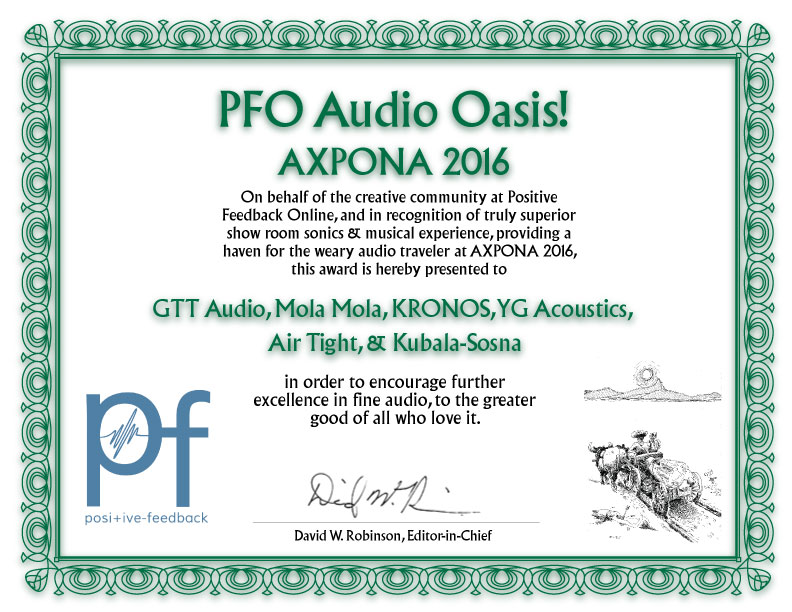
As usual, GTT's Bill Parish put on a cracking show at AXPONA. Congratulations to all involved!
Whew! Production of the DAC boards has finally started but production of the USB input module is delayed. What this means is: if you're very impatient we can actually sell you a Makua with a DAC (or fit a DAC in your existing Makua) if you can live with only an AES or SPDIF input. The input module can be retrofitted later.
Positive Feedback Online editor David Robinson instituted the Oasis award a couple of years ago to honour those demo rooms that stand out by sounding truly musically involving. This year that accolade went to the On A Higher Note room. Truth be said, despite Philip's occasionally unconventional methods he invariably manages to get absolutely great sound and almost all visitors went out of their way to tell us that "he's done it again!" It is also gratifying that the products made by 'objectivist' engineers like Vivid's Laurence Dickie and myself are becoming recognized for their ability to convey musical emotion.
A full 2 months late our new metal supplier finally shipped 3 cases for sign-off. Yes,
we're grumbling now but as they say, a few years hence we'll just look back and smile.
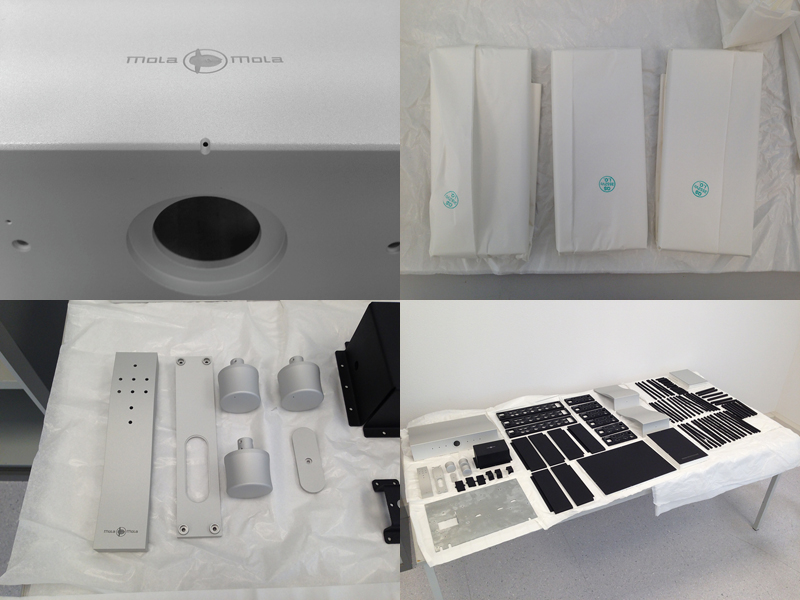 Next thing is to build up these 3 sets and note any items that may need correcting and
then, finally, ordering the first full batch of 50 sets. Either I can't believe it's
taking so long or I can't believe it's finally moving...
Next thing is to build up these 3 sets and note any items that may need correcting and
then, finally, ordering the first full batch of 50 sets. Either I can't believe it's
taking so long or I can't believe it's finally moving...
Life's been way too interesting in the lab to sit down and report on the progress of the
DAC. For the past few days I've been trying to find ways to force the Audio Precision to
measure reliably to around -140dB. So far the only thing that has some impact is
manually setting the input range a few notches higher. Otherwise, no luck. So this is
where we are now.
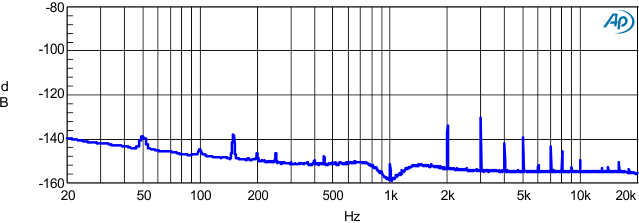 The distortion spectrum at higher frequencies looks pretty much the same so I'm going to
spare you a clutter of graphs. I'll post a full report later once the last firmware
wrinkles are ironed out. But as a word of warning here's an illustration of something I
mentioned in the previous DAC post.
The distortion spectrum at higher frequencies looks pretty much the same so I'm going to
spare you a clutter of graphs. I'll post a full report later once the last firmware
wrinkles are ironed out. But as a word of warning here's an illustration of something I
mentioned in the previous DAC post.
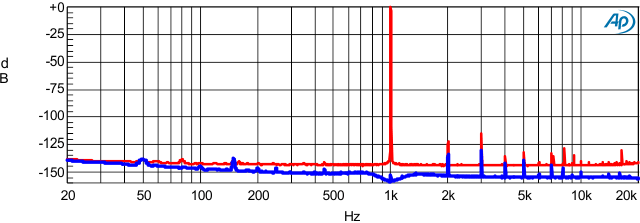 The blue graph is the same as above. The red graph is what you get if you make the
common mistake that both manufacturers and reviewers can be seen to commit: to convert
the whole signal to digital without notching out the fundamental first using the
distortion analyzer. Clearly the red graph would have looked precisely the same even if
the signal had been perfect. Every distortion product is dominated by the analyser's
10-year-old ADC chip. I'm mystified as to how people think they can design a high end
DAC if they can't see the effect circuit changes have on the low-level stuff.
Of course using the notch filter only improves matters to a degree. It is not distortion
free either, just a lot better. In particular with the second and third harmonic I have
no way of judging what they are in reality. Probably a goodish bit better than -130dB.
The higher order ones can be chalked up to the DAC, that much I'm certain of. But at
least we can conservatively conclude that this prototype has a full scale THD+N of
-127dB (0.000045%) and probably lower. Uncharted waters.
The blue graph is the same as above. The red graph is what you get if you make the
common mistake that both manufacturers and reviewers can be seen to commit: to convert
the whole signal to digital without notching out the fundamental first using the
distortion analyzer. Clearly the red graph would have looked precisely the same even if
the signal had been perfect. Every distortion product is dominated by the analyser's
10-year-old ADC chip. I'm mystified as to how people think they can design a high end
DAC if they can't see the effect circuit changes have on the low-level stuff.
Of course using the notch filter only improves matters to a degree. It is not distortion
free either, just a lot better. In particular with the second and third harmonic I have
no way of judging what they are in reality. Probably a goodish bit better than -130dB.
The higher order ones can be chalked up to the DAC, that much I'm certain of. But at
least we can conservatively conclude that this prototype has a full scale THD+N of
-127dB (0.000045%) and probably lower. Uncharted waters.
Johan Cruijff (Yogi Berra's Dutch twin brother) once said that 'every disadvantage has
its flip-side'.Well that's what's been happening at Mola-Mola the past few months.
Every day the casework gets delayed is another day to refine what's going inside even
further. So this week Philip O'Hanlon (of On A Higher Note fame), Joe Kubala (of the
eponymous cables), GTT's Bill Parish and myself got together in Bill's office to take
stock of the latest developments and do some tweaking as required. I should note that
what Bill calls his office is really a place that most people would be proud of to have
as their main listening room. You can get an impression in this PFO article
http://www.positive-feedback.com/Issue70/gttaudio.htm. The
speakers in our test were the
new YG Acoustics Halle. I've got something of a weakness for effectively designed 3-way
speakers and boy do these hit the sweet spot.
On the agenda were a switch-mode power supply for the preamp, the finalized phono stage
and the prototype of the DAC. For me the power supply was a big thing: with all options
fitted the preamp was running warmer than the power amps which is more than a bit
ironic. Well the SMPS fixed that. So then the question: how did it sound? Well, straight
out of the lab the SMPS performed commendably but in terms of openness and air it fell
noticeably short of its linear counterpart. This rather changed after adding a
C-multiplier circuit to the output (that's a kind of linear regulator but with minimal
voltage loss). That tweak not only restored the resolution of the original unit but it
introduced a poise and even-handedness in the tonal balance that the linear supply
couldn't match.
Those who follow my career will know that I'm not a great vinyl collector. As a result I
was most anxious to hear how the purely technically engineered phono stage would hold up
against competing products that had benefited from years of listening and tweaking. Well
in short, it smoked 'em The most outstanding sonic feature of the Mola-Mola phono stage
is absolute consistency in presentation across the whole spectrum and a soundstage that
remains uncluttered without trading in low-level detail.
Finally the prototype DAC was fired up and pitted against a $80k player synched to a
Grimm clock. This was by far the most intriguing test in that the differences were
surprisingly slight. The choice of digital filter made itself known in the lack of
'splash' in the leading edges, and more generally as an 'analogue' feeling on the part
of the Mola-Mola. I've always been struck by the fact that even though a trumpet is made
of metal, it never actually sounds metallic in real life. Quite logical when you think
of it of course, it's the air that makes the tone not the metal. But still I got
reminded of that when switching from the reference back to the Mola-Mola and the
metallic edge disappeared leaving the beautifully rounded tone of that magical piece of
brass. The reference responded with slightly juicier lower mids but we couldn't agree on
whether this was truer to the recording or not. I think we have a winner here. For me
that had always been the plan of course but the other guys felt that this DAC is already
too good merely to squirrel away inside a preamp as a plug-in board. Especially when you
consider it's eating up 20W and comes as a stack of 4 boards, enough to fill a whole
chassis. Long story short, I've overshot the target and the first Mola-Mola DAC to come
out will be a standalone unit.
I'd have loved to have the DAC ready for showing at the CES but I think there are better
ways of driving myself -or Bart for that matter- crazy. In terms of physical
construction it's just not ready for showtime but qua performance it shows all the
promise I was hoping for.
The design work on the DAC is paying off,and Bart's heroic microscopic tinkering even
more so. Here's an FFT taken at full scale (suppressed fundamental, more about that
later).
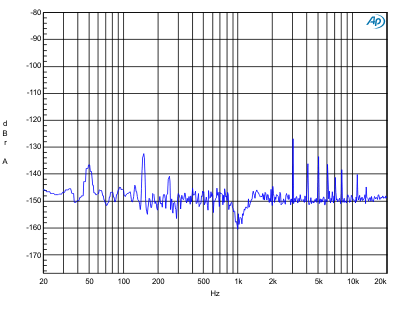 The second and third harmonics are more or less where I know the AP2722's residual
distortion to be. What remains is a minor smattering of higher harmonics. As incredibly
low as they are, we still want to be shot of them before we start mass production. It's
mostly a matter of pride, we're unaware of DAC makers claiming the kind of performance
we're already getting.
The second and third harmonics are more or less where I know the AP2722's residual
distortion to be. What remains is a minor smattering of higher harmonics. As incredibly
low as they are, we still want to be shot of them before we start mass production. It's
mostly a matter of pride, we're unaware of DAC makers claiming the kind of performance
we're already getting.
On the grounds of power dissipation in the analogue stages we'll have to differentiate
the DAC into two models. The one we're doing now is for the preamp option and has an SNR
of 130dB (132dB 'A' weighted) which still constitutes a record. For a later standalone
product we can go flat out, at the expense of over 10W extra dissipation. Distortion
performance will be similar for both (i.e. impossible to measure).
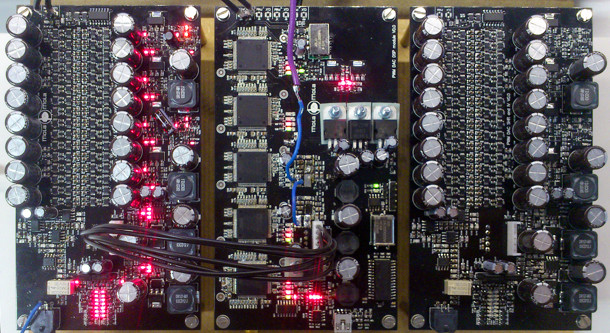 A minor note to prospective audio reviewers: I cringe every time I see a distortion FFT
with the fundamental still present. The ADC in the AP is not at all bad, but it is not
up to par with the Mola-Mola or even with the current crop of competing DACs. You really
have to run the signal through the AP's notch filter first like I did on the plot above.
Not doing so ultimately leaves you with a distortion plot of whatever Cirrus Logic chip
they've got in there. With this DAC you'll still be ultimately limited by the test
instrument but at least the result will be closer to the truth.
A minor note to prospective audio reviewers: I cringe every time I see a distortion FFT
with the fundamental still present. The ADC in the AP is not at all bad, but it is not
up to par with the Mola-Mola or even with the current crop of competing DACs. You really
have to run the signal through the AP's notch filter first like I did on the plot above.
Not doing so ultimately leaves you with a distortion plot of whatever Cirrus Logic chip
they've got in there. With this DAC you'll still be ultimately limited by the test
instrument but at least the result will be closer to the truth.
By now you'll probably have noticed that delivery keeps slipping. This is not because of the electronics - the optionless preamp and the power amps have been finished for a long time. It's the chassis. Apparently Mola-Mola's industrial design department (yours truly) has come up with a shape that's really sexy but incredibly critical in terms of manufacture and finish. Everything shows. We've burned two prospective chassis suppliers so far. A popular saying round here is 'third time right' and #3 certainly looks the part. They're busy making the extrusion die so first off tool samples should be round the corner soon.
Newport was a good show. As usual Philip had some amazing recordings lined up. The
digital highlight must surely have been the two Brahms dances that Channel Classics'
Jared Sacks had added to a recording session on the spur of the moment just a month
earlier. On tape there was Roy Gaines & Anthony Wilson. Quite a few people rushed out to
get a copy after hearing it in our room. All sold out in the first two days of the show.
On vinyl Philip managed to lay hands on Doug McLeod's newest, "There Was A Time". So
that sold out too.
I also got invited by a charming fellow called Peter Roth to take part in a round-table
discussion between amplifier designers. The others were Jim White of Aesthetix and steve
McCormack of SmC. Probably the most thought-provoking question that got asked was to
give a run-down of advantages and disadvantages of our respective technologies. It's an
interesting one because it's clearly framed to fit the quintessentially American
preoccupation for "balance". You line up pros and cons so that nobody comes out looking
silly regardless of which way they choose.
That kind of balance is often illusory. What are the pros and cons of class D? For once
in a live discussion I didn't fumble the answer, which went something like this: whom
are you asking? If you're asking the user, keep in mind that they've just bought a
small, light amplifier that wastes little energy, has lots of power reserve, sounds
great and generally does what it says on the tin (clearly I'm assuming a good class D
amp, I believe I make those). I can't think of any disadvantages from a user
perspective. Provided the class D amp is fully mature, there is literally nothing on the
"con" side of the balance.
Any and all disadvantages land squarely on the designer's shoulders. Class D is an
astoundingly complex technology. If you want to do it well, prepare for a lot of math.
There are virtually no rules of thumb of the sort "tweak x and y will improve". When you
move to class D you get good efficiency straight off the bat. The rest are problems:
"how do I make it bullet-proof?" or "how do I prevent RFI" and most importantly "how do
I get great sound?". In many linear amps, especially FET and valve based ones, the
distortion is to a large degree euphonic so if the design of a good error control system
gets overwhelming there's always the escape route of leaving the distortion in and
claiming that this sonic footprint was what you were after all the time anyway. Class D
offers no such cop-out. The open-loop distortion of a class D amp is not particularly
interesting sonically so your only option is to eliminate it completely. That's right:
the only good sound you can get from a class D happens to be "identical to the input
signal". Well isn't that what high end audio should be about anyway?
The question "what are the pros and cons of class D" throws an interesting philosophical
curve-ball at the whole idea of "balance". The user gets al the pros, the manufacturer
gets all the cons. I suppose that's why users pay manufacturers so the principle might
be a general one.
The Mola-Mola project was kicked off in January 2012. Jorrit Mozes camped down in our
lab in Belgium to design the case work while I sat down to do schematics and PCB's.
Prototypes were assembled in April and first shown in May at the 2012 High End Show in
Munich.
Everyone loved the sound and the aesthetics. After-hours shootouts for potential
distributors showed that the units punched far above their weight, with much more
expensive products not even putting up a modicum of resistance.
The fly in the ointment came as I slid our preamp proto (later baptized Makua) into a
rack for one such demo. To understand my befuddlement you ought to know that said rack
space had just been vacated by what I'd call a glorified variac but what was probably a
'autoformer-based passive preamplifier'. It had two big knobs, one for source (three
positions) and one for gain (twenty-four 2dB steps). Rotating them took considerable
force and both went alarmingly clunk as one did so. It was, in other words, esoteric.
And its distributor had just asked me whether Makua had a remote control.
Here's the mistake I made in not including one. When a product looks like it's been
designed in a basement decked out with Buddhist paraphernalia and the electrical
circuitry (such as it may contain) is a highly intimate statement of one's most personal
artistic genius, nobody asks for a remote control. One doesn't question High Art and
demand that it be practical. But as soon as some degree of engineering is evident, like
the presence of an actual gain stage or the absence of distortion, the product becomes
pedestrian and it'll have to use the zebra crossing like anyone else.
My second mistake was telling people that production hadn't already started. 'Oh but in
that case you should definitely add a balance control. And a mono switch. And extra
outputs. And actually you can't do without an iPhone app because remote controls get
mislaid.'
Looking back I must admit those people were right though. Owing to their feedback the
Makua has matured inestimably. Internal construction has become extremely neat and
uncluttered. Signal routing is programmable, all jumpers have been eliminated. The
Bluetooth receiver doubles as a wireless audio input when a DAC is installed. The volume
control now uses relays, resulting in better tracking and lower distortion than a
motorized potentiometer could have offered. The discrete amplifiers have become
phenomenally good and stable. But it has added a full year to our schedule. It was worth
it.
A tiny overlooked detail. Sharcs have at best 40-bit 'extended precision' floating point numbers. PC's use 80 bits. Even after subsampling to a few kHz the ratio estimator ran headlong into precision problems. And that is already using a state variable filter (don't even try that with a direct form filter). Ever tried programming double precision using a single precision floating point processor? Nope, neither has anyone else on Google. It's actually not possible, not like in fixed point where you can just break down a long word into shorter ones. But I did find you can do error shaping when you're slowly integrating a small number. Contact me privately should you stumble on this blog whilst looking for a solution. Anyhow it's all s&d now on the DSP firmware end. Bart has just finished gerbers. It's going to be a long hot summer.
At this point I should tell you that we've been joined by a new boy called Bart who has
been taking an enormous amount of work off my hands. This DAC is going to be as much his
work as mine. So far he's coded the PWM algorithm onto a Sharc DSP and started the board
layout of the analogue stage. It seems I've been woefully optimistic in my original
cycle estimate. One channel of PWM uses up the best part of a complete DSP chip. The
very minimum DSP chip count for a stereo DAC will be 3. I suppose this is good, because
a lot of DSP's in a DAC has always been good for bragging rights.
On my end the asynchronous upsampler is working, at least in M code. First you get 4x
upsampling, then an 11x7 filter yields coefficients for a 6th order polynomial which is
exact to around the 30th bit. Within the audio band though it's closer to 34 bits. Good
enough I should think. The ratio variable stabilizes (reasonably) at 1 bit per doubling
of lock time. Apart from the inband ripple that was actually why I didn't want to use an
SRC chip. At best their ratio estimator's bandwidth is around 10Hz which still allows a
fair bit of jitter in. Ours is in the microhertz region after a few minutes.
A propos of nothing. If you should ever start designing op amps, will you please keep in mind that every inverting stage (every common emitter stage including current mirrors and diff pairs) has an inherent right-half-plane zero. The reason I'm saying this is because all standard literature seems to think that only the transimpedance stage (painfully misnamed VAS in audio circles) has this problem. Nope, twice nope, thrice nope. The reverse capacitance of any device acts as a noninverting feedthrough over a nominally inverting amplifier. And since the time constant is defined by the cob and gm, degenerating your input pair might well make it the dominant source of phase shift.
The PWM algorithm works! It looks exactly like I imagined it would, except that somehow imagination did not paint in all the details. Ow. For the few who follow this (oh hi Lars), the goal is to run a filter at a 3.125MHz reference frame (the PWM rate) while the PWM transitions that encode the signal and the shaped noise are moving about between the samples. After an estimate is made of the crossover point based on the signal alone, a look-ahead estimate is made of the filter states at that point in time. Then the crossover point is corrected, rounded and the filter states bumped up by precalculated amounts found in a lookup table. See? Told you it was simple. Now I just need a few missed nights of sleep to catch up with.
Just for the record. Forget capacitors. Potentiometers is where all the trouble is.
Those who remember the old leaflet (now taken down) may note our proud use of a P&G pot.
Credit where credit is due: it is extremely good. Sadly, they couldn't do a motorized
version so it had to go. So one of our distributors pointed us to a Japanese brand that
makes motorized pots for a variety of audiophile companies. That should have rung alarm
bells but sadly only after designing them in I discovered that they distorted. Less so
than the highly reputable amplifiers that they were put to use in, but too much to be
sure it'd be inaudible. So I'm down to relays and fixed resistors. I found something
that works quite nicely with no glitches. It's really smooth. It costs about the same as
the P&G pot, so all in all we're in the money.
Did you know that some relays produce significant amounts of distortion? Take a reed
relay (any brand, I tested Coto) and apply a current through the contact. If you measure
across that contact you'll see a fair amount of distortion as frequency goes up. It's
caused, I realise now, by the fact that reed relays are magnetic and the signal current
sets up a changing field in the reeds. Although I still have doubts about the claims
made by prophets of iron-free chassis, it seems that it certainly pays to keep iron some
distance away from the signal path if there's a fair bit of current flowing.
For several years now I've been promising people that I'd design a new DAC based on the
ripple-compensated PWM scheme. Much has happened since it was first published
(http://www.hypex.nl/docs/papers/AES120BP.pdf).
The most important bit is the
realisation that this modulator transforms almost trivially to its z-domain equivalent
using impulse invariance. All it took to design a modulator for said new DAC was to
define an elliptic high-pass filter with stop-band at 87kHz and the coefficients for the
control loop come rolling out after a few more lines of MATLAB code.
(While I'm writing this a correspondent pointed me to a fairly insane white paper by a
chap who seems to claim that since the Sabre chips physically convert at 6 bits, it
can't be good for high end audio. What twaddle. Somehow someone must have been on
another planet when noise shaping and dynamic element matching were invented.
Information theory tells us that 6 bits at 48MHz is ample to fully encode the spectrum
of anything you could conceivably call audio while noise shaping theory tells you
exactly how to go about it.)
I think what we'll do is run this modulator at a PWM frequency of 3.125MHz quantized at
100MHz. A full PWM cycle then fits a 32-bit shift register. Summing the outputs through
32 equal resistors already eliminates most of the outband energy so we should be able to
get away with a fairly standard I/V topology. Since each tap alone carries the full
signal, resistor matching is not at all critical.
Writing a good asynchronous upsampler for a DSP should not be rocket science. The only
seriously tough nut would be shoehorning the modulator, which integrates samples at
100MHz, into a 400MHz DSP. I have some ideas. Later.
Mola-Mola is not exactly the first company claiming to leave the sound untouched. One
way or another, virtually all designers believe that their particular philosophy is best
suited for transmitting all of the information in the sound. So why do their methods
differ so much, and why do their deeply held beliefs regarding some basic technologies
(transistors, fets, valves, analogue, digital) often flatly contradict those of other
designers who profess the same goal?
'Revealed preference' is what economists call voting with one's feet. If you want to
know what someone really wants, study their behaviour and ignore what they say. After a
new design checks out in the lab the vast majority of audiophile designers set it next
to an older design (theirs or someone else's) and listen alternately to both using music
that they're familiar with, in a room they're familiar with and with ancillary equipment
that, well, has been with them for a bit as well.
I don't think I'm misrepresenting anyone's practice here. But there's something
fundamentally wrong with this idyll. No, not the use of one's favourite room and
speakers. That makes perfect sense. Look again, then I'll help.
Here's the problem. The hidden assumption is that the comparative listening test will
somehow reveal which of the two DUT delivers the truest signal. How can this be if you
don't know what the input signal sounds like? At best comparing two boxes will tell you
which produces a signal that to you sounds most like the internal platonic ideal you've
built up over the years. Reviewerese has words like 'warm' and 'musical' which are
overtly subjective. Much more treacherous though are terms like 'transparency' or
'precision' that do precisely the same thing ' label the listener's subjective
experience ' while very much contriving to suggest a more objective observation.
Psychologists studying aesthetics have known for a long time that platonic ideals of
perfection are formed by averaging. This has been famously shown for human faces using
morphing but it holds just as well for audio kit. So someone who subscribes to the view
that negative feedback is evil will preferentially listen to low-feedback amplifiers and
come to get used to their idiosyncrasies and absorb them into their platonic 'ideal
amplifier'. If you hit that sweet spot for a given reviewer, you hit the jackpot.
The above would seem academic to most. It would to me too if the solution weren't so
blindingly obvious. There is no need to compare, say, two preamplifiers and guess which
one is more right. Why not compare the input signal with the output signal?
It's as simple as this:
Take one preamp of which you want to know what it does to the sound. Call that the
'device under test'. Carefully set the volume control of the DUT to unity gain. Then,
use a second preamplifier (the 'monitor pre') that you'll use as a selector and volume
control. Using a Y split cable, feed the source into the DUT and into one input of the
monitor pre. Feed the output of the pre under test into another input of the monitor
pre.
Set the volume of the second pre to a comfortable level, put on some music and do a
comparative listening test just like you'd ordinarily do. But instead of comparing which
you like most, concentrate on how similar or different the two are. The smaller the
difference, the more accurate the pre under test. Of course instead of a pre you could
test an AD/DA converter. Or a power amplifier (with a dummy load and a resistive divider
at the end).
The monitor pre doesn't have to be identical to the DUT. Perhaps it's even better if it
isn't. And since it'll always be in circuit we don't really care whether it's perfectly
neutral either since the only differences that will turn up are caused by the pre under
test.
Those differences can be quite instructive. Often as expected the stereo image does
shrink and some impact is lost but equally often I've heard devices whose output signal
at first appeared to sound more pleasing, spacious and detailed than the input signal.
Invariably though after longer listening the effect began to pall and became that of a
condiment indiscriminately sprayed onto every dish.
When you're testing preamps a second attraction of this test is that you can repeat it
with the two boxes swapped. This way you can take two completely unknown preamplifiers
and still work out which of the two is most transparent. You don't need a 'reference
preamp' because the reference is the input signal, not another pre.